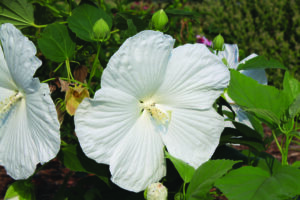
Hibiscus “Blue River” can grow 4-5 feet tall and spread up to 3 feet and bears pure white flowers that can spread up to 10 inches wide. (Photos by Ginny Rosenkranz)
August is usually a hot and dry month and sometimes it seems that very few plants are blooming in the gardens.
It may be hot and dry but there are some very lovely plants that bloom with huge and often brilliantly colored flowers even in August.
Hibiscus is a cultivar or nativar of the Hibiscus moscheutos, also known as swamp mallow, which grows best in full sun and moist, organically rich soils.
They are herbaceous perennial shrubs growing 3-6 feet tall and 2-5 feet wide with green leaves and colorful flowers with 5 petals that can grow 6-8 inches wide and come in white, pink, red or burgundy.
Because the swamp mallow is so lovely, there are many nativars have been hybridized to bring brighter colors and larger flowers to the gardens.
Hibiscus “Summer in Paradise is a lovely compact and bushy plant that has maple shaped green leaves and brightly colored cherry red saucer shaped flowers that spread 7-8 inches across.
The flowers last only 1 day but with the large number of buds, the plants are covered with new flowers each day from June to September.
Another nativar is Hibiscus “Berry Awesome ”is also a compact but bushy herbaceous perennial that is sometimes called the dinner plate hibiscus because the pinkish lavender flowers can spread up to 8 inches wide.
Like most Hibiscus, “Berry Awesome ”has a brilliant red eye in the center of the flower.
This is natures way of calling on the pollinators to feast on the nectar of this beautiful Hibiscus.
Hummingbirds are often viewed hovering over the open flowers and diving into the center red circle for the nectar they need.
Both butterflies and moths and other pollinators visit the flowers as well.
There are 28 species of butterflies and moths in their caterpillar stage will feast on the foliage, so it is always a good idea to plant the Hibiscus close enough to enjoy the flowers but far away enough to hide the nibble on foliage.
Native bees also visit the flowers including the solitary native Hibiscus bee, also known as the Eastern digger bee which collects the pollen.
The female bee will walk on the surface of water to moisten the hard backed soil so she can lay her egg in a vertical nest that is surrounded by a muddy turret or chimney.
Hibiscus “Blue River ”can grow 4-5 feet tall and spread up to 3 feet and bears pure white flowers that can spread up to 10 inches wide.
The flowers have a satiny texture, and have creamy white stamens for a soft contrast.
It is called “Blue River ”for the beautiful blue green foliage that provides a fabulous backdrop to the beautiful and abundant flowers.
There is a series of Hibiscus under the name Bloomables, with the sales name Head Over Heels® Passion™ Hibiscus.
This lovely, compact plant grows only 3 feet tall with a 4 foot spread and features striking burgundy foliage that makes its 8 inch wide, deep pink flowers with crimson red centers truly glow.
Hibiscus plants thrive in a variety of gardens including Rain gardens, pollinator gardens, perennial borders, as low but vibrant hedges or even in containers.
Since they are slow to emerge in the spring — waiting for the soil to fully warm- it’s a good idea to cut back the branches in late fall and leave about 4 inches of stem.
This not only marks their location; it allows native bees to place their eggs in the stems and also ensures that the gardeners remember where to expect new growth.
Once summer heat arrives, lush green or burgundy foliage will emerge, soon followed by a dazzling display of tropical like blooms that seem to float above the leaves.



